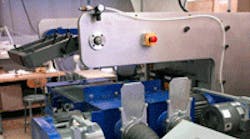Making beautiful music not only depends on talented musicians, but also on the talents of instrument makers. When it comes to guitars, nothing is as important as the quality of the fret board. That's why its machining is such a critical operation in guitar manufacturing; both the board's straightness and accuracy of the radius make a significant contribution to the instrument's quality and playability. Although fret board production relies on the know-how of highly skilled technicians, part of the process has recently become automated for renowned acoustic guitar manufacturer, Martin Guitar (CF Martin & Co.), Nazareth, Pa., with the help of motion control components from Baldor Electric Co., Fort Smith, Ark.
A custom woodworking machine using Baldor’s Ethernet-compatible motion control components includes dual sanding belts and a swinging work holder. The latter is controlled by a combination of linear and rotary servomotor axes. Before the automation update, Martin Guitar produced the required finish using a special swinging jig that held the fret board and presented it to a motorized sanding belt. However, particles often clogged the sanding belts and caused vibration, so the boards had to be processed twice to achieve the required finish.
Martin Guitar wanted to upgrade this manual process. Fred Walters, Martin’s engineering project manager, asked a local machine builder, Brian Rasley of Rasley Enterprises Inc., to investigate the process. Rasley spent time with project and production managers along with operators and all agreed that a more controlled sanding process could enhance the quality of finishing as well as improve throughput.
More flexible and powerful sanding belts are a key component of the new solution. Rasley decided that he would need to create them himself, and discussed this aspect of the application with Baldor. A Baldor engineer advised Rasley on the use of vector motors to drive belts, but also discussed how the other movements could be implemented by servomotors and integrated into a real-time system using Powerlink Ethernet.
Together, the two companies conceived a motion control architecture that employs six axes of motion to automate sanding. Two vector motors power the rough and smooth sanding belts. Two servomotor axes with ballscrew jacks are used to raise the belts after the work piece has moved across the sanding faces. Finally, the swing-arm jig that holds the fret board is powered by two axes of motion — a servomotor to swing the fret board in an arc, plus a linear motion axes that moves the swinging arm across the sanding belts. The linear motion is the most critical of the axes, and for this task Baldor suggested using a linear motor with cog-free action. In this motor, a special layout of the magnetic elements eliminates the tiny ripples of movement that can take place as the motor transitions between magnetic poles, providing an ultra-smooth action.
Using this automation architecture, Rasley developed an algorithm for controlling the sanding process that removes the material in small increments and exploits the width of the sanding belts to aid uniformity and minimize the clogging effects of sawdust particles. Different woods also benefit from variations in the sanding process, and Rasley provided operators with a touchscreen human-machine interface that allows them to load the optimum sanding routine.
Using Powerlink simplified the electrical design of the machine. One network cable is all that's required to link the four precision motion axes, reducing the size of the cabinet and the wiring task. The other axes are connected directly to the controller. Programming the system was simplified with Baldor's Mint development environment for Powerlink. This machine control language features English-like, high level commands for common motion tasks, effectively providing ready-to-use software routines for much of the motion required. Two simple lines of code are all that's required to interpolate the two rotary and linear axes that control the swing arm jig. In use for six months, the machine has boosted sanding speed by around 60% and has virtually eliminated rework.
Visit Baldor Electric Co. for more information.

